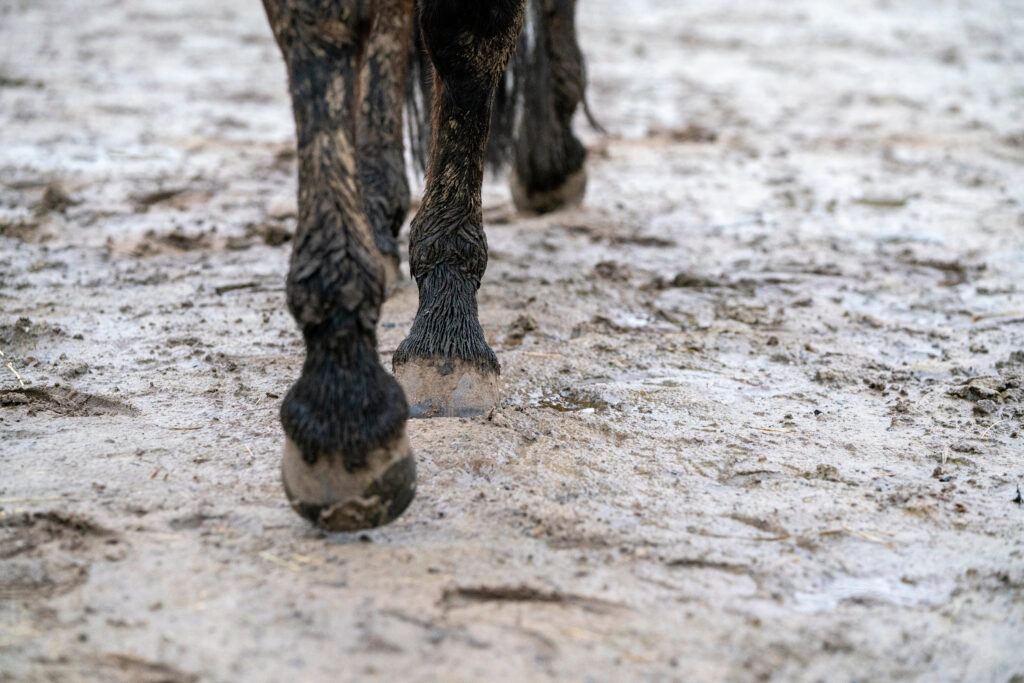It all starts from the ground up, and that’s why a common adage in the horse world is, “no hoof, no horse.” If you’re trying to wrap your mind around the basics of hoof health, we’ve gathered up 5 articles that will give you a leg…or hoof… up.

Article: Reading Your Horse’s Hooves
In this article from Barb Crabbe, DVM, this veterinarian discusses basic ways to read your horse’s hooves.
Excerpt: Your horse’s entire body weight is suspended over his four relatively small hooves. And on those hooves he runs, jumps, and makes his way along the trail. For your horse to stay sound, his feet must function properly to provide cushioning, traction, and easy movement.
“Foot balance” is a common term. But what does it really mean? Unfortunately, the answer isn’t quite as simple as it seems. Does it mean the foot is perfectly symmetrical? That it’s shaped with ideal angles measured by a farrier’s tool? Or that it has a specific landing pattern when it hits the ground? It depends. While all these concepts enter into the equation, a balanced foot will vary with each individual horse—and that’s what’s most important.
Hoof balance really means that the hoof is trimmed and/or shod for an equal distribution of the horse’s weight over the entire foot, and for minimum stress to joints and soft-tissue structures when the horse takes a step. A skilled farrier will “balance” the foot based on the horse’s conformation, natural hoof shape, and pattern of movement.
[Read the rest of the article HERE]
Article: Healthy Feet for Happy Trails
This article from 2015 breaks down the importance of hoof health for a happy trail horse.
Excerpt: Hoof horn is like your fingernails—the insensitive outer covering protects the inner, sensitive living tissues. Keeping the hoof wall and sole healthy and strong prevents problems like hoof cracks, abscesses, thrush, and white line disease. Keep the feet dry to maintain the hoof wall’s strength. As is true for your fingernails, constant moisture can weaken the hoof horn. It becomes softer, making it harder for the hoof to hold a shoe. It also becomes more damage-prone, or likely to wear away too quickly if the horse is barefoot. Continuous wet-dry cycles are hard on feet as well—just as being in and out of water is hard on your hands and can lead to cracking.
[Read the rest of the article HERE]
Article: Hoof Nourishment
Check out this article that discusses the vitamins, minerals, and supplements that can benefit your horse’s hooves.
Excerpt: The biggest source of minerals in your horse’s diet is the soil in his pasture and in that bale of hay you just dragged down from the loft. Like other nutrients, minerals need to be in balance. The principle minerals to look for in a hoof supplement are calcium, phosphorus, zinc, copper, manganese, cobalt, and chromium. Again, work with an equine nutritionist to determine the right mix if you really believe targeted supplementation will help.
Caveat: Watch your horse’s selenium intake. Selenium, a mineral, adversely affects your horse whether there’s too much or too little in his system. If selenium is plentiful in your local soil, steer clear of hoof supplements containing selenium. (Also avoid feeding an antioxidant supplement with selenium.) Signs of selenium toxicity include ridged hooves that eventually lead to severe lameness and detachment of the hoof wall from the hairline. This is a very painful condition and can be fatal.
[Read the rest of the article HERE]
Article: What’s Up With Quarter Cracks
If you’re struggling with quarter cracks, check out this article from the H&R editors that breaks down what this issue is, and how to treat it.
Excerpt: Quarter cracks have various causes. This includes trauma to the coronary band, a prior injury to the coronary band resulting in the growth of defective horn, and poor conformation resulting in excessive weight-bearing on one side of the foot. Other conformation faults that can be factors include long toes with under-run, poorly functioning heels (a major cause); severely toed-out or toed-in feet; offset knees; and small hooves on a large horse.
Commonly, horses with thin hoof walls and poor hoof quality are also predisposed to quarter cracks. Hoof care resulting in imbalanced feet and/or an improper footfall. Or where one side absorbs excessive stress when the foot strikes the ground, can occasionally be a factor as well.
[Read the rest of the article HERE]
Article: What is Thrush?
With wet, spring conditions on the way, thrush is a common problem that can affect hoof health. Read this article to learn how to fight this bothersome condition.
Excerpt: Once thrush takes hold, it’s fairly simple to detect. It emits a foul odor and appears as a black pus-like fluid. The black color of thrush will be visible in the clefts against even the gray color of a naturally dark hoof. As the frog is affected, it, too, will become black and spongy. If present in one foot, thrush is often found in all four feet to varying degrees.

Though thrush doesn’t typically cause lameness, it can cause soreness if it migrates deep into the hoof’s sensitive tissues. Your horse might flinch when you pick his feet if he is suffering from thrush. He may exhibit lameness, and may even bleed at the site of infection.
[Read the rest of the article HERE]






